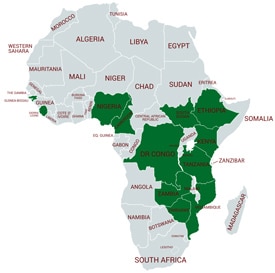Cholera in Africa
See large version of Africa map with country-specific cholera information.
Cholera, largely eliminated from industrialized countries by water and sewage treatment over a century ago, still remains a significant cause of illness and death in many African countries.
Improving global access to water, sanitation and hygiene (WASH) is a critical step to reducing Africa’s cholera burden. From the late 1990’s through the first decade of the twenty-first century, sub-Saharan Africa has reported more cholera cases and more cholera deaths than any other region. With some exceptions, this trend has continued through most years of the second decade of this century. The region is broadly affected by many cholera cases and outbreaks that can spread across countries 1.
The proportion of people who die from reported cholera remains higher in Africa than elsewhere. This reflects the lack of access to basic healthcare as most cases of cholera can be treated with simple rehydration therapy 2.
Surveillance
The World Health Organization (WHO) maintains a public database of cholera cases. It also provides outbreak updates and an annual summary of aggregate national data in the Weekly Epidemiological Record.
- Weekly Epidemiological Record: Annual Reports
- Africa Region Outbreak News and Bulletins
- Global Health Observatory Data Repository
- Regional Cholera Platforms in Africa
The reports provide relatively consistent national and regional profiles of cholera over time, and reflect the success and failure of efforts toward its prevention and control. However, they underestimate the true number of cholera illnesses that occur. In fact, WHO estimates that these officially reported cases of cholera represent only 5–10% of the actual number occurring annually worldwide because of inadequate laboratory and epidemiological surveillance systems and economic, social, and political disincentives to case reporting 1.
